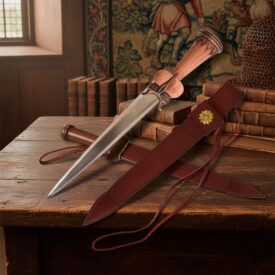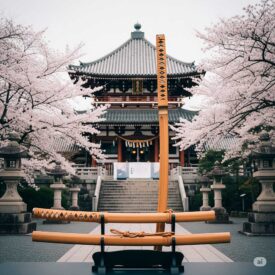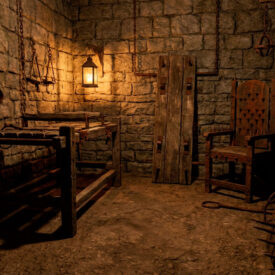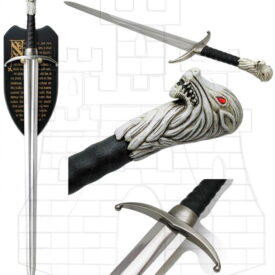In the annals of Middle-earth, few artifacts inspire as much dread and fascination as the legendary Morgul Blade. It is not a simple piece of forged metal, but a weapon imbued with the darkest sorcery, an instrument of corruption designed to drag its victims into the veil of shadow. What secrets does this fearsome blade hide? What is its true origin, and how did it manage to sow such terror in the hearts of mortals?
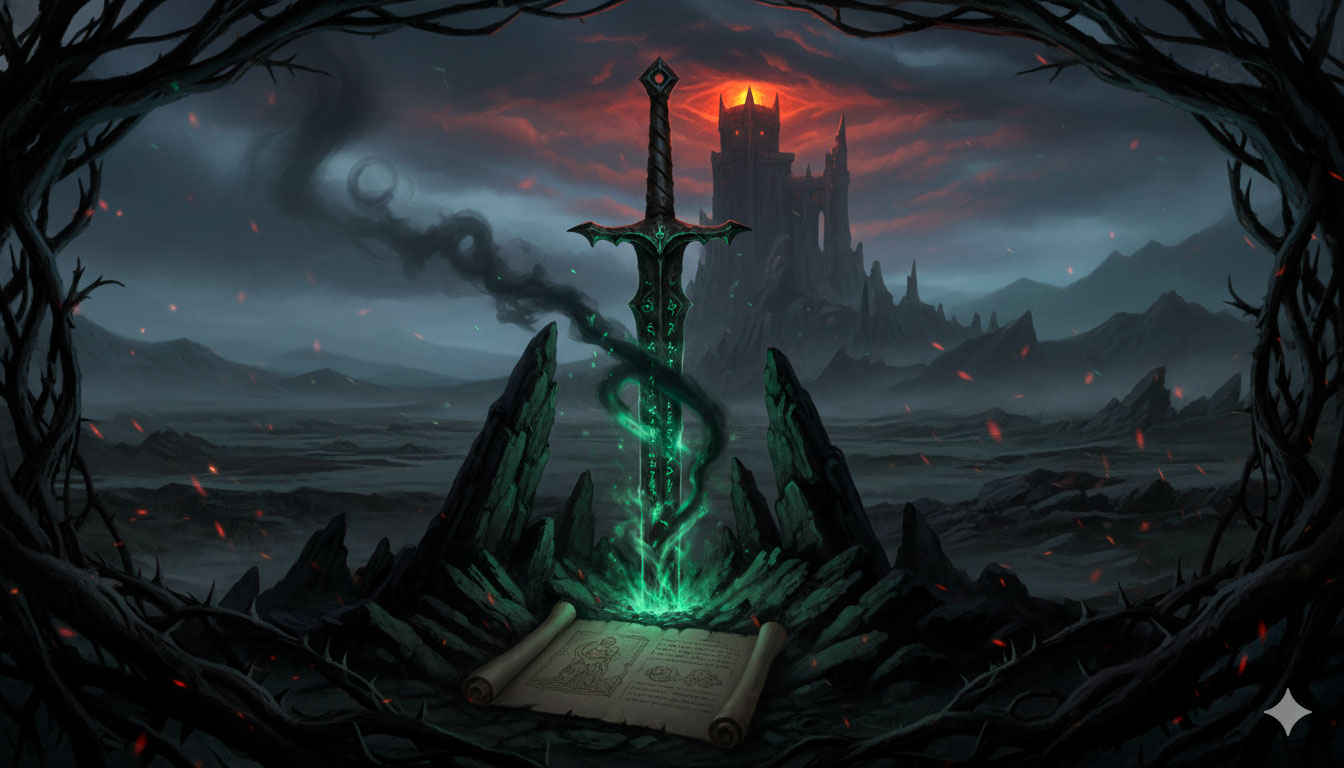
Delve with us into the chilling history of the Morgul Blade (or, more precisely, the Morgul Knife), unraveling its purpose, its wielders, and the trail of despair it left in its wake, from the forges of Minas Morgul to Frodo Baggins’ shoulder.
The Morgul Blade: History and Milestones of the Weapon of Corruption
The following table chronologically orders the main milestones of the so-called “Morgul Knife” (or “Morgul Sword” in popular usage), integrating canonical textual tradition and the recontextualizations shown in Peter Jackson’s films.
| Era | Event / Details |
|---|---|
| Second Age | |
| General Origin | The first Morgul knives are forged in the foundational stages of Sauron’s power; they are artifacts of deep antiquity and malice intended for spiritual corruption. |
| c. II 2250 | Approximate academic dating attributed to the creation of the first Morgul knives. |
| Purpose | Designed to corrupt the spirit: the blade seeks to gradually transform the victim into a wraith bound to the will of Sauron. |
| Forging Mechanism | Canonically, the blade is conceived to fragment upon wounding, leaving an embedded malignant piece that advances towards the heart and corrupts the soul. |
| Third Age — Cinematic Reappearance (The Hobbit) | |
| Appearance in Dol Guldur | In the films, Radagast the Brown recovers the blade in Dol Guldur after an encounter with the shadow of the Witch-king. |
| Gandalf and the White Council | Gandalf tries to present the blade as evidence of Sauron’s resurgence to the White Council; Saruman questions its cinematic authenticity. |
| History of Sealing | Galadriel and Elrond state on screen that the blade had been sealed by powerful Elvish magic in the High Fells of Rhudaur where the Witch-king was buried. |
| Cinematic Continuity | Filmmakers indicate that the blade recovered in The Hobbit is the same artifact later used to stab Frodo; the film does not show the prior fragmentation described by textual tradition. |
| Age of the Weapon | It is emphasized that, at the time of the War of the Ring, the weapon would be over four thousand years old. |
| Third Age — War of the Ring (Weathertop and its consequences) | |
| Attack at Weathertop | The Witch-king of Angmar attacks Frodo. He carried a long sword, but also used a Morgul knife — described as a knife that shone with “pale light” — to wound Frodo. |
| Immediate Consequence | The Morgul knife breaks/disintegrates upon wounding, leaving a fragment embedded in Frodo’s shoulder that begins to corrupt his essence. |
| Aragorn’s Response | Aragorn (Strider) recognizes the “cursed knife” and applies Athelas (Kingsfoil) to mitigate immediate effects; this does not constitute a total cure but temporary relief. |
| Proximity to the Unseen Realm | The wound causes Frodo a “slight transparency”: his essence draws closer to the Unseen World inhabited by the Nazgûl, increasing the spiritual danger. |
| Healing and Permanent Legacy | |
| Elrond’s Intervention | In Rivendell, Elrond successfully locates and extracts the blade fragment from Frodo’s body, preventing him from becoming a physical wraith under Sauron. |
| Limit of Healing | Although Elrond counteracts the immediate threat, the fundamental spiritual damage cannot be completely eliminated through the healing of Middle-earth. |
| Chronic Effect | Frodo suffers permanent sequelae: an incurable spiritual scar and recurrent episodes of pain and exhaustion that return annually on the anniversary of the attack. |
| Final Destiny | To find relief and peace, Frodo requires the health and power of the Undying Lands (Aman/Valinor); his wound leaves him “uprooted” in Middle-earth. |
Note on Nomenclature: Canonically, the correct term is “Morgul knife” or “Morgul dagger” — a weapon specifically designed for spiritual corruption — and is distinct from the “long sword” also carried by the Witch-king. The term “Morgul Blade” became popular due to replicas and cinematic iconography (a piece whose replica size usually approaches 63.3 cm), but the text insists on the nature of a dagger/knife and its traditional fragmentation mechanism.
Dark Origins: The Forging of Evil in Minas Morgul
The Morgul Blade was not born from the hand of a common smith, but from the purest darkness. Minas Morgul, formerly known as Minas Ithil, was the forge of its malignant purpose. Captured by the forces of Sauron, this city was transformed into a crucible of black magic, where weapons imbued with the very essence of dark sorcery were created. The name “Morgul” is no coincidence: “Mork” means black or dark and “ole” means sorcery, revealing the true nature of the weapon: “black sorcery.”
These weapons were not mere tools of war, but magical objects, created with the intention to corrupt and weaken, designed to exist only in the shadow that sustained them.
Corrupting Nature: The Poison of Shadow
What made the Morgul Blade such a fearsome weapon was not its ability to inflict physical wounds, but its power to corrupt the spirit. Upon stabbing a victim, the blade not only caused pain but fragmented, leaving a shard impregnated with evil that made its way to the heart. This shard initiated an insidious process, seeking to transform the wounded into a wraith, a servant of Sauron lacking free will. It was a strategic weapon to replicate the devastating effects of the One Ring, drawing victims into the Unseen World.
The official replica of this fearsome weapon, used by the Nazgûl, features an AUS-6 steel blade with acid finishes. Its metallic hilt, leather-wrapped, offers a firm grip and an authentic finish.
Error: Debes especificar al menos un "categoria_id" o "fabricante_id".
The Bearers of Darkness: The Witch-king and the Nazgûl
The Morgul Blade was the preferred weapon of the Witch-king of Angmar and the other Nazgûl, the nine Ringwraiths, Sauron’s most powerful lieutenants. These dark beings did not brandish these blades at random, but in precise and lethal attacks against those who posed a direct threat to their lord. Whoever wielded this sword understood its purpose: it was an instrument for corruption and spiritual enslavement, a weapon reserved for a specific end.

The Attack at Weathertop and its Consequences
The most notorious incident involving the Morgul Blade was the attack on the hobbit Frodo Baggins at Weathertop. The Witch-king stabbed him with this blade, leaving a fragment embedded in his shoulder. Aragorn, with his ancestral knowledge, recognized the weapon’s curse and tried to mitigate its effects with herbs, but the wound was not merely physical. The black magic corroded Frodo’s spirit, drawing him irremediably closer to the Unseen World.
It was in Rivendell where Lord Elrond’s high Elvish magic managed to extract the shard, saving Frodo from becoming a wraith. However, the spiritual damage was incurable, leaving a permanent scar that would torment Frodo annually on the anniversary of the attack. Only the journey to the Undying Lands could offer him total peace.
Another affected by the influence of the Morgul blades was Boromir, the eleventh Steward of Gondor. Although he died from his wounds, he managed to escape the terrible transformation into a wraith; his death came before the curse was completed.
Clarifying Mysteries and Secrets about the Morgul Blades and Minas Morgul
What other magical objects existed in Minas Morgul
 Based on Tolkien’s lore, Minas Morgul contained several magical objects and artifacts besides the famous Morgul Blades:
Based on Tolkien’s lore, Minas Morgul contained several magical objects and artifacts besides the famous Morgul Blades:
In the Witch-king’s Tower
The central tower of Minas Morgul probably housed a library or study dedicated to dark magic, which would contain ancient scrolls of curses, strategic maps of Gondor and Rohan, and captured relics of fallen enemies. The Witch-king kept trophies such as shattered swords of Western heroes and helms of defeated Gondorian captains.
Enchanted Weapons
Beyond the Morgul Blades, the city produced weapons and armor imbued with dark magic. It is specifically mentioned that the Witch-king possessed a mace (a kind of war mace) that was enchanted through his magical powers. These weapons were manufactured in special forges located in the tower or in the city’s smithies, where orcs worked under the supervision of evil men or even Ringwraiths.
Artifacts of Sorcery
In the deep chambers of the tower, forbidden even to the Witch-king’s servants, there were summoning rooms where ancient sacrifices were performed under the watchful eyes of deformed idols. On the blackened marble altar at the top of the tower, with profane runes carved into its surface, the Lord of Morgul uttered incomprehensible incantations and wove spells, such as those that created the Great Plague that scourged Gondor centuries ago.
How is the Morgul Blade related to other Tolkien artifacts
The Morgul Dagger is related to other artifacts in Tolkien’s legendarium in several significant ways.
Relationship with the One Ring
Its most important connection is with the One Ring. The Morgul weapon amplifies Sauron’s influence over his victims, making them more susceptible to the Ring’s power and the Dark Lord’s dominion. This directly links it to the hierarchy of malevolent artifacts created by Sauron, with the One Ring being the central piece of his power.
Connection with the Nazgûl
The Morgul Dagger was commonly carried by the Witch-king of Angmar and the other Nazgûl, making it an integral part of their identity. These spectral beings used this weapon as an extension of their corrupt nature, reflecting how artifacts in Tolkien function as mirrors of their wielders’ souls.
Parallel with Other Legendary Weapons
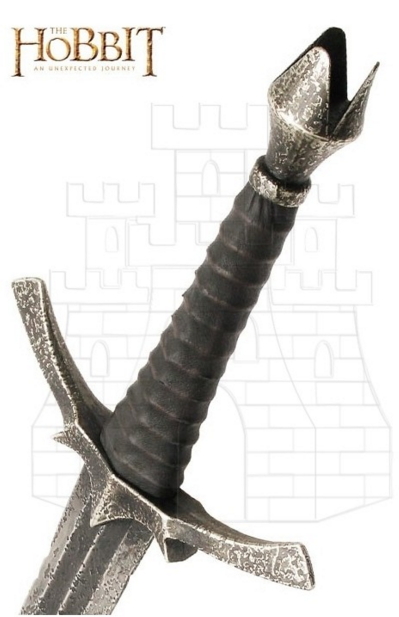 Unlike heroic swords like Aragorn’s Narsil (later Andúril) or the hobbits’ Sting, which represent light and justice, the Morgul Dagger embodies the opposite side of the spectrum of power artifacts in the legendarium. While Andúril symbolizes restoration and royal legitimacy, the Morgul Dagger represents corruption and malignant transformation.
Unlike heroic swords like Aragorn’s Narsil (later Andúril) or the hobbits’ Sting, which represent light and justice, the Morgul Dagger embodies the opposite side of the spectrum of power artifacts in the legendarium. While Andúril symbolizes restoration and royal legitimacy, the Morgul Dagger represents corruption and malignant transformation.
Unique Transformative Capacity
What distinguishes the Morgul Dagger is its ability to turn mortals into wraiths, a unique magical effect that could only be countered by high-level Elvish medicine, such as that provided by Elrond. This ability positions it as one of the most dangerous artifacts in the legendarium, surpassing many other weapons in intrinsic evil.
What does the Morgul Blade symbolize in The Lord of the Rings plot
The Morgul Blade symbolizes deep evil and darkness in The Lord of the Rings plot. It is not a common weapon: it carries a magical curse, and its main purpose is not only to wound physically but also to weaken will, drain spiritual strength, and begin to turn the victim into a wraith enslaved by the shadows and Sauron. Thus, the sword represents the corruption of the soul and enslavement to evil exercised by the Nazgûl, agents of Sauron, being a key instrument for their dominion and terror in history.
What forging techniques were used in Minas Morgul to create magical weapons
In Minas Morgul, no specific forging techniques are mentioned for creating magical weapons. Magical weapons associated with that place, such as the Morgul blades used by the Nazgûl, were forged through dark magic and malignant enchantments, but no concrete metalworking methods or artisanal processes employed in the city are detailed.
How did the Morgul Blade’s black magic affect its victims
The Morgul Blade’s black magic affected its victims by causing wounds that did not heal easily and leaving splinters in the flesh that facilitated the spread of a curse. This curse slowly corrupted the victim, turning them into a wraith similar to the Nazgûl, but weaker and more manipulable. The process was painful and progressive, and only Elvish medicine could stop it. If the victim did not receive help, they would die or become trapped in the world of shadows.
The Inexorable Legacy of the Morgul Blade
The story of the Morgul Blade culminates with the destruction of the One Ring and the defeat of Sauron. With the disappearance of the evil forces that sustained it, these fearsome blades also vanished from the world. Their existence was intrinsically linked to the darkness of their creator, and without it, they could not endure. However, their legacy is indelible: an enduring symbol of absolute terror and corrupting power in the history of Middle-earth. It reminds us that, even in the realms of fantasy, the true battle is often fought in the soul.
VIEW MORE OFFICIAL HOBBIT AND LORD OF THE RINGS SWORDS | VIEW MORE OFFICIAL HOBBIT PRODUCTS
